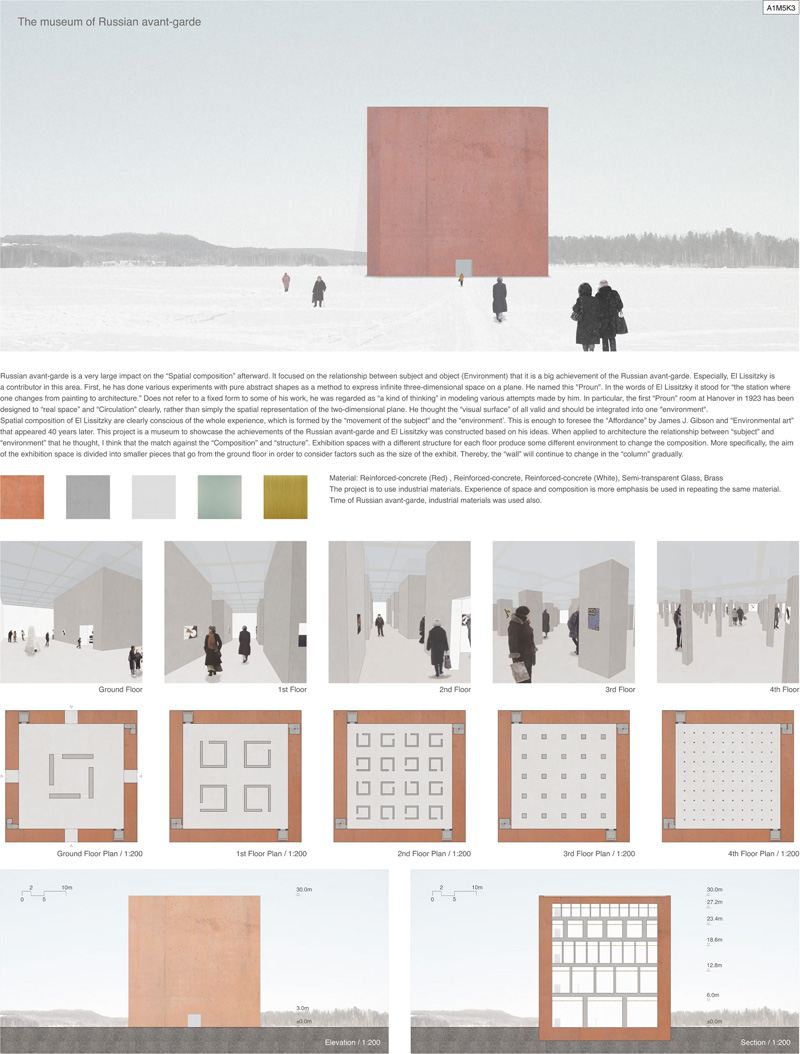Музей русского авангарда / The museum of Russian avant-garde
Музей русского авангарда
Русский авангард оказал очень большое влияние на дальнейшие развитие «пространственной композиции». Он поставил в центр внимания отношения между субъектом и объектом (средой). В частности, первая «Комната Проунов» Эль Лисицкого в Ганновере в 1923 году явно образовывала «реальное пространство» и «движение», а не просто пространственное представление двухмерной плоскости. Он считал, что «визуальная поверхность» должна быть интегрирована в единую «среду».
Пространственные композиции Эль Лисицкого подразумевают полное погружение, формирующееся «движением субъекта» и «средой». Наш проект - музей, который показывает достижения Русского авангарда и Эль Лисицкого и построен на основе этих идей. Что касается архитектуры, отношения между «субъектом» и «средой» - это соревнование между «композицией» и «структурой».
Выставочные залы с разной планировкой для каждого этажа создают различную среду для изменения композиции. Выставочное пространство измельчается при подъеме с первого этажа, чтобы дать возможность размещения выставок разного масштаба.
The museum of Russian avant-garde
Russian avant-garde is a very large impact on the “Spatial composition” afterward. It focused on the relationship between subject and object (Environment) that it is a big achievement of the Russian avant-garde. Especially, El Lissitzky is a contributor in this area.
First, he has done various experiments with pure abstract shapes as a method to express infinite three-dimensional space on a plane. He named this "Proun".
In the words of El Lissitzky it stood for “the station where one changes from painting to architecture.”
Does not refer to a fixed form to some of his work, he was regarded as “a kind of thinking” in modeling various attempts made by him.
In particular, the first “Proun” room at Hanover in 1923 has been designed to “real space” and “Circulation” clearly, rather than simply the spatial representation of the two-dimensional plane.
He thought the “visual surface” of all valid and should be integrated into one "environment".
Spatial composition of El Lissitzky are clearly conscious of the whole experience, which is formed by the “movement of the subject” and the “environment’. This is enough to foresee the “Affordance” by James J. Gibson and “Environmental art” that appeared 40 years later.
This project is a museum to showcase the achievements of the Russian avant-garde and El Lissitzky was constructed based on his ideas. When applied to architecture the relationship between “subject” and “environment” that he thought, I think that the match against the “Composition” and “structure”.
Exhibition spaces with a different structure for each floor produce some different environment to change the composition.
More specifically, the aim of the exhibition space is divided into smaller pieces that go from the ground floor in order to consider factors such as the size of the exhibit.





Добавить комментарий